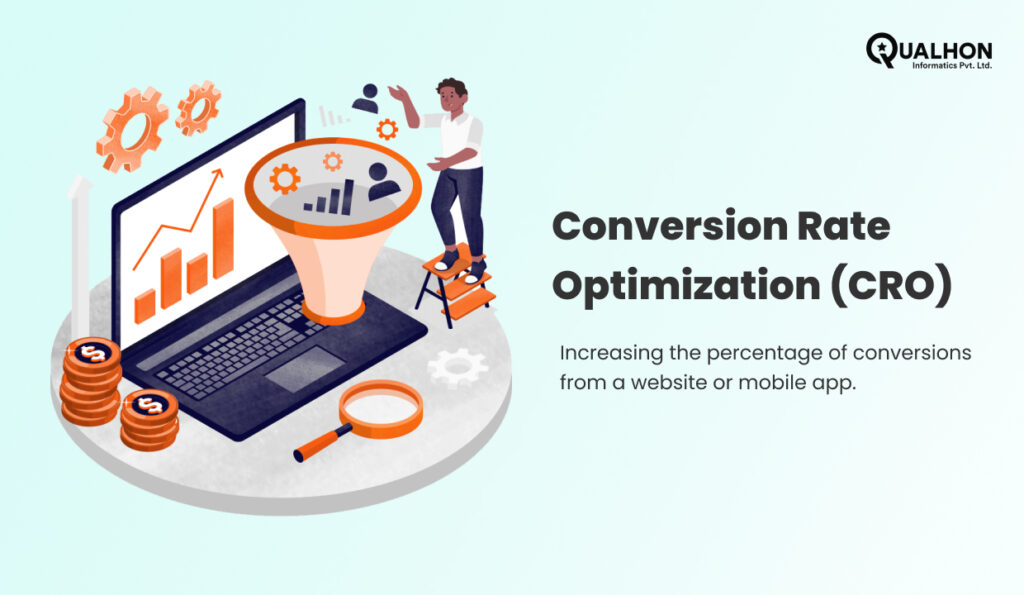Imagine you’ve spent a ton of money on marketing, only to find that visitors to your website aren’t converting at the rate you had hoped. It can be frustrating to see your investment go to waste. However, a solution exists – conversion rate optimization, or CRO. It’s a powerful tool that can help you increase conversions and ultimately drive more revenue. Whether you’re looking to increase sign-ups, boost sales, or simply make your user experience more streamlined, CRO is the way to go. CRO helps improve the user experience and makes it easier for visitors to take action. With the right tools and strategies, we can see a significant increase in our conversion rates and take your business to the next level. This article dives deeper into CRO techniques and explores how businesses can master the art of turning visitors into loyal customers.
It can be calculated with a simple formula i.e.
Conversion Rate = (Number of Conversions/ Total number of Visitors) * 100
Now, before you roll your eyes and click away, hear me out. Think about it: if your website gets a ton of traffic but nobody buys anything, what’s the point? a powerful catalyst for business success. Whether you’re looking to increase sales, generate leads, or build brand awareness, CRO can help you achieve your goals.
- Understanding CRO: CRO (Conversion rate optimisation) is a data driven approach for optimizing conversions from a Website or Mobile Application.
- Unlocking Growth Potential: CRO helps businesses bring in more customers and drive more sales by analyzing user behavior and website performance data thus improving conversion rates, resulting in increased revenue and profitability.
- Customer-Centric Approach: By prioritizing CRO, businesses demonstrate a commitment to delivering a seamless user experience and enhancing customer satisfaction.
- Optimizing Marketing ROI: CRO works to convert casual website visitors into paying customers by improving the user experience and call-to-action on a website thus ensuring a higher percentage of visitors convert, ultimately boosting the return on investment.
Implementing the right tactics can make all the difference when it comes to converting leads into paying customers. There are several strategies businesses can use to optimize their website for conversions. These strategies include optimizing landing pages, using A/B testing, providing a strong call-to-action, improving user experience, and leveraging personalization.The key is to test, analyze, and optimize relentlessly until the desired results are achieved.You can use the tips and tricks for better CRO. These are the key conversion rate optimization strategies for effective CRO:
- Optimizing landing pages: involves creating targeted content that speaks directly to the audience and includes features such as customer testimonials or product videos. This type of content makes the page more engaging and increases the likelihood of conversions.
- Clear and Compelling Call-to-Action (CTA): We can use persuasive and action-oriented language for CTAs, making them stand out and clearly communicating the value proposition.
- A/B Testing and Experimentation: We can use A/B tests to compare different elements in a website such as headlines, colors, forms, images, layouts, and CTAs. We can analyze the data to identify best website variations that drive higher conversions.
- Streamlined User Journey: Here we simplify the navigation and minimize the number of steps in the website required to complete a conversion.This reduce distractions and guide users towards the desired actions.
- Compelling Value Proposition: We need to make a strong value proposition that clearly communicates the benefits of our product or service.High-Converting Landing Pages: Optimize landing pages with persuasive copy, visually appealing design, and prominent calls-to-action. Test different layouts, headlines, and visuals to identify winning combinations.
- Personalization is a powerful tool for CRO: Personalized content and messages can help create a sense of connection with visitors, increasing the chances of conversion. Businesses can leverage data points such as age, gender, or location to tailor their website experience to each individual user.
Ultimately we need to focus on creating a seamless, user-friendly experience across all devices. Ensure fast loading times, mobile responsiveness, and intuitive navigation for a positive user experience.
Once the data has been gathered and analyzed, businesses need to develop a strategic plan to improve their website. This could involve redesigning pages, adding new features, or revising the overall website design. This strategic thinking should be informed by customer feedback, competitor research, and industry trends. Companies should focus on creating a website that is tailored to their target audience and provides a positive user experience.
Conversion rate optimisation services include monitoring, analyzing, and iterating is an ongoing process that is essential for successful CRO. By constantly assessing and refining their website, businesses can create an engaging experience that drives conversions. This is done as following:-
- Data-Driven Decision Making: Continuously monitor and analyze user data, conversion rates, and key metrics. Leverage insights to make informed decisions and prioritize areas for improvement.
- Heatmaps and User Recording: Utilize heatmaps and user recording tools to gain visual insights into user behavior, identify engagement patterns, and optimize page layout and design accordingly.
- Feedback and Surveys: Collect feedback from users through surveys or feedback forms to understand their pain points and preferences. Use this information to refine your website and improve the user experience.
- Multichannel Optimization: Extend CRO efforts beyond your website to other marketing channels such as email campaigns, social media, and paid advertising. Ensure consistency and optimization across all touchpoints.
Finally, businesses must remember that CRO is an ongoing process and requires continuous experimentation. They should continually be testing different design elements and making adjustments to optimize their website for conversions. They should also monitor their progress and use analytics to track website performance and identify areas for improvement. Prioritizing conversion optimisation empowers businesses to unlock the full potential of their website and capitalize on their existing traffic to drive business success in the competitive digital landscape.
By incorporating the aforementioned tips and tricks into their operations, small startups can level the playing field and challenge even the largest corporations. These are the tips for startups to beat big companies in their operations and lead generation.



